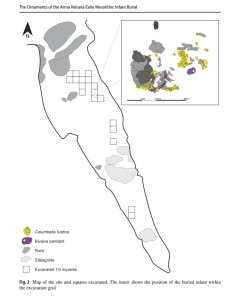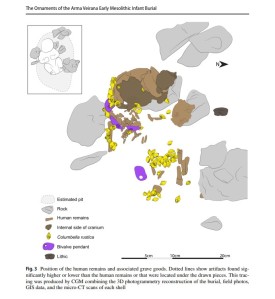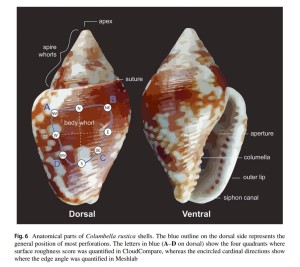One of the complications of studying infant care in history, let alone prehistory (before writing), is that organic materials do not survive, that includes the clothing and carriers, as well as the bodies of infants themselves. The lack of remains has many causes: fewer births in preagricultural societies, infants grow into adults, and the remains of infants who do not survive decay more quickly, including skeletal remains due to bone composition.
So when a prehistoric infant burial is discovered it is a huge deal, more so when an infant burial is found with grave goods. Grave goods are usually associated with status, achieved or ascribed, being so young infants are unlikely to have achieved status, therefore they would need to be born with ascribed status for goods to be interred with them, including a status like having personhood.
Instead of high status, there is a theory that heavy ornamentation of infants may be communicating high level of care for the infant, protection from evil/harm. When the ornaments are second hand, or gifted by other members of the community that locus of care is expanded. And they point out that among Pueblo Indians, when a baby or child dies the ornaments given to them for their protection are cremated with them to avoid another person using them.

In 2017, in the Arma Veirana cave in Italy, archaeologists discovered an infant burial associated with stone tools and shells. The female baby was around 40-50 days old at death, interred in a fetal position, knees drawn up to chest (which was common in prehistoric European burials for adults). All across the prehistoric world, seashells are common decorative items and networks of trade can be traced through them, but these sea shells weren’t positioned in a way to be jewelry or set on the body as funerary decoration being hid by the position of the baby, knees to chest, but attached to something around the infant which kept them in place through decomposition. Which led researchers to believe that this seashell adorned wrapping may have been clothing or an infant carrier used during the baby’s lifetime.
The shell beads were well worn, used not only during the infant’s life but potentially for many years prior, especially those found near the head of the baby which had higher amounts of ochre, possibly from prior staining of the seashells or thread used to string them and attach to the wrapping. The three pendants are believed to have been worn by members of the community prior to their use by the infant, and the use wear patterns suggest they were worn in the same way.
Eagle owl talon which had been briefly used as an ornament in a small pit next to the burial, believed to be an offering. Another offering of a matching 4th pendant, which was more worn with time, was found at the same depth of the eagle owl talon. The cave and burial remained undisturbed until someone with a matching pendant, who knew the baby’s gravesite, returned to make the offering.
Sources:
The research team has a YouTube channel The Cultural Heritage Engineering Initiative (CHEI), https://chei.ucsd.edu) at UC San Diego: https://www.youtube.com/user/CISA3Video
Hodgkins, Jamie, et al. 14 Dec 2021. “An infant burial from Arma Veirana in northwestern Italy provides insights into funerary practices and female personhood in early Mesolithic Europe.” Nature, Scientific Reports 11 (23735).
Gravel-Miguel, C., et al. 30 Aug 2022. “The Ornaments of the Arma Veirana Early Mesolithic Infant Burial.” J Archaeol Method Theory 30(3):757-804. doi: 10.1007/s10816-022-09573-7.
Cassella, Carly. 29 Sept 2022. “Ancient Burial of a Young Girl Shows How We Carried Our Babies 10,000 Years Ago.” Science Alert.









